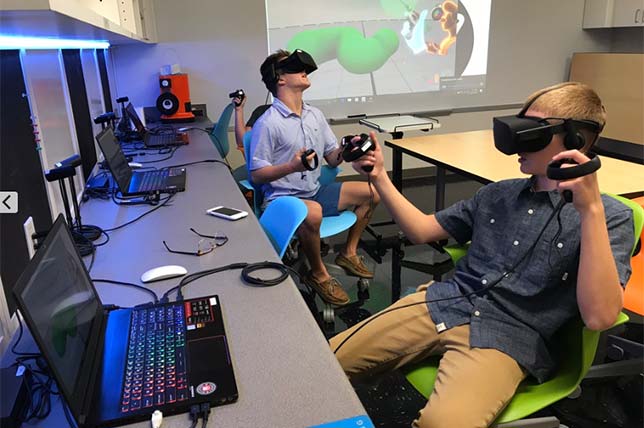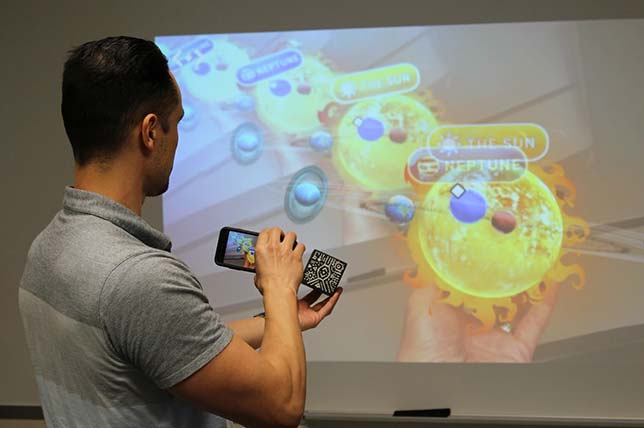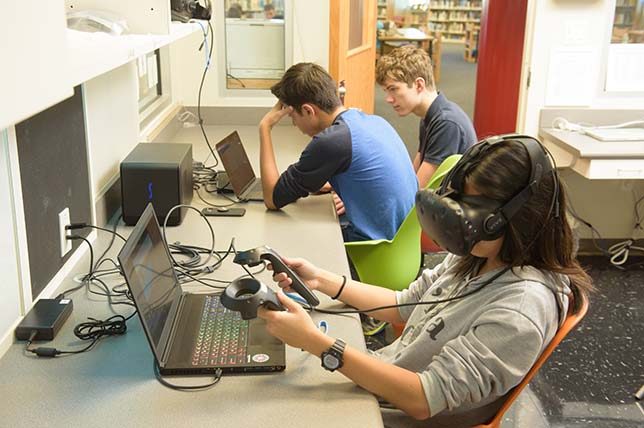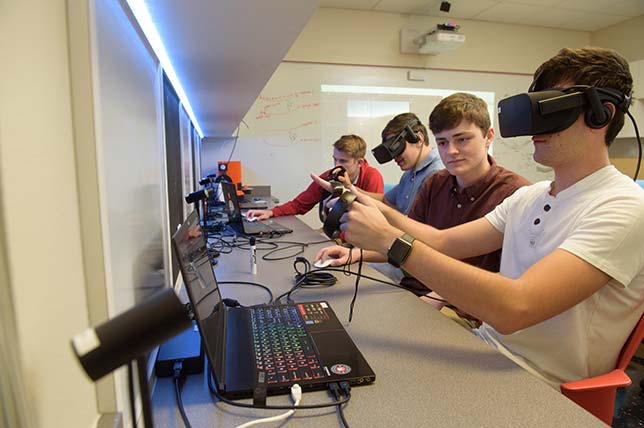VR Lab!

When Tampa Preparatory School launched decided to turn a closet into a virtual reality lab, they had no idea how far their students would run with the tools, but that's exactly what they did, sitting down to build their own educational apps to help visualize concepts in astronomy, chemistry and physics. In addition to the educational apps, built by students on their own initiative, the VR lab is also used for art classes and more.
Chad Lewis, director of technology at Tampa Prep, recently sat down with THE Journal to talk about the school's experience with VR as an educational tool.
Tell me a little about having students design their own VR apps. Are there any benefits to it that surprised you?
Chad Lewis: Some surprising benefits included branching out beyond computer science into areas like chemistry and physics. This is an example of the amazing things students can do if given the opportunity to pursue their passions. They need time, space and resources as well as support and encouragement. Many times educators' egos get involved, and if we think we must be the sole source of knowledge and expertise in a particular subject this can really hold learning back, especially when it comes to technology, which changes so quickly. That's not to say that we shouldn't be lifelong learners. For example, I'm learning Unity 3D in my spare time just playing catch-up to some of the students.

Why have students build the science VR apps themselves? Building apps makes sense, of course, but why apps built for specific classes or subjects instead of games or something? Are you using off-the-shelf academic apps with the VR lab, as well?
Lewis: The original discussion was not about making educationally relevant applications for virtual reality. I would have been pleased if they were just building games. It's the process that's important. The outcome of having these science apps was just gravy. The main thing is that they're learning coding, 3D modeling, game development, collaboration, design thinking, etc.
By the way, the app selections were student ideas. For example, one of the students was having difficulty visualizing molecule binding in chemistry. Sometimes a molecule might be behind another in Z-space which is difficult to draw in 2D space on paper. Virtual reality is the perfect solution, because it's a 360-degree environment where students can rotate, zoom and move around to see the entire structure. As for pre-made applications, we are using Medium, a virtual-reality sculpting app, Nature Treks for mindfulness training, Calcflow for vector calculus and many other primarily immersive apps of everything from anatomy, to undersea and space exploration.

Investing in a VR lab sounds expensive. Why go that extra mile instead of offering programming for more traditional computing environments?
Lewis: Actually the entry point into VR creation was less expensive than many schools are paying for mobile virtual reality kits, but they are "one trick ponies," primarily for immersive experiences with very little student interaction and no creation options. Creation is the highest level of learning. Each virtual reality creation station cost us around $1,800 all in. Keep in mind that the lion's share of the cost was the laptops, which are also used for other functions like 3D modeling, AutoCAD, etc. So if you already have a computer lab with decent video cards on the computers, the cost of entry to virtual reality isn't that bad.
Tampa Prep seems to have done a good job of integrating the VR lab with diverse curricular areas. How did you make that happen? Did teachers come to you, or did you have to push for it? Was wide buy-in part of the pitch in bringing the lab to campus, or did it come later? Do you have any advice for other educators looking to integrate VR across the curriculum?
Lewis: The cross-curricular pollination of VR has come as a pleasant surprise. We started our research into what virtual and augmented reality might mean for education in the fall of 2016 with Google Expeditions. Then we moved to student creation of virtual reality environments with Cospaces, primarily in the middle school. In November 2016 we purchased an Oculus Rift and mounted it to a mobile Conen display with an Epson Brightlink projector so that we could bring it into the classrooms.
In the process, one of our computer science students came up to me and said, "Mr. Lewis do you mind if I try to create some virtual reality apps using Unity?" and it really took off from there. The lab was a student-driven initiative.

The creation of the six-station lab has had some surprising outcomes. Now we have a student VR Creation Club and next year will have a VR/AR creation class. In addition this lab has led to a new STEAM initiative. We have one of the art classes creating virtual sculptures with an app called Medium on the Oculus Rifts. They can save these sculptures as 3D models and either print them out on the 3D printers or send them to the computer science students to use as assets in their Unity projects. It's a great way to expose art students to 3D modeling technologies. I knew that art creation has a lot of potential with virtual reality as a new method for creation, so over the summer I gave an Oculus Rift to one of our art teachers to use and she now uses it in her classroom with her students.
For schools that maybe don't have the resources to invest in a full-blown VR creation lab, do you have any advice as to how to start small with an eye toward scaling up in the future?
Lewis: My advice for schools is to just start looking into VR in any way they can that will fit into their budgets and school culture. This can be with anything from Cospaces to Unity 3D. Even just 360 image and video creation with Thinglink has the potential for a lot of cross-curricular use.
It seems like no tech implementation ever goes perfectly smoothly. Did you face any surprising challenges with your lab? How did you overcome them? Or, what challenges did you anticipate and how did you mitigate them? Basically, what would you do differently if you were starting over today?
Lewis: I really wouldn't do much differently. We reclaimed a storage room in the library that was filled with old assets and built a creation lab dubbed the IDEA Lab (which stands for Innovate Design Explore Apply). The lab has all of the VR laptop stations connected to an Epson projector which can display a 7 foot image of any of the laptop screens onto a Walltalker dry erase wall which makes for a great teaching space as well.
About the Author
Joshua Bolkan is contributing editor for Campus Technology, THE Journal and STEAM Universe. He can be reached at [email protected].